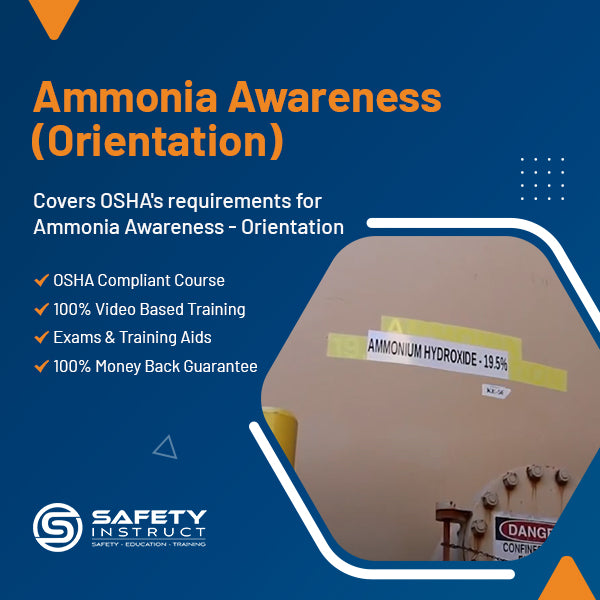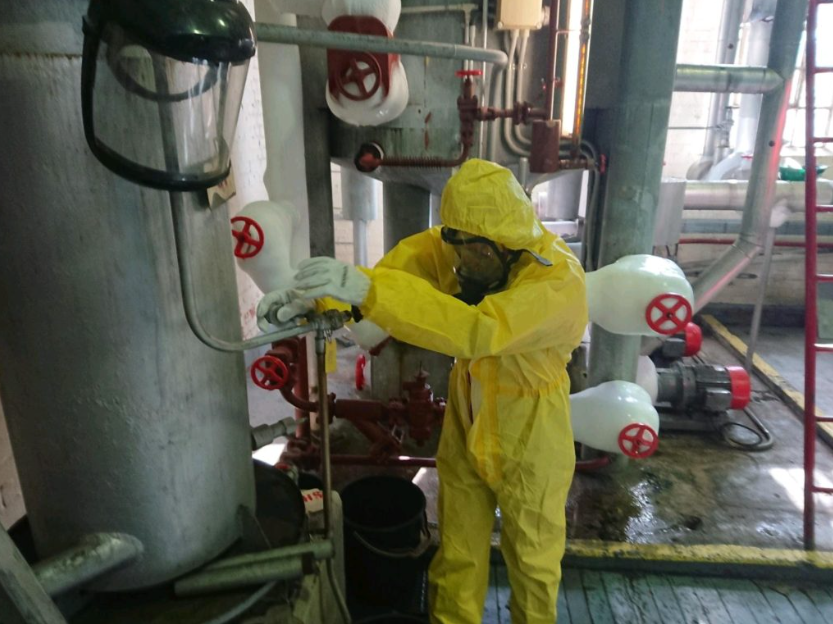No Products in the Cart
Click Here to Schedule a FREE Consultation
Phone: 866-943-6887 Email: sales@safetyinstruct.com



A chemical utilized in numerous products and applications, Ammonia can post significant risks if not handled properly. Refrigerants, water purification, and fertilization of crops are just a few of the common uses of this chemical. The Ammonia Awareness Orientation provide essential knowledge and practical guidance for individuals working with or around ammonia. With this training, participants will be equipped to mitigate risks, promote workplace safety, and protect the well-being of themselves and others.
What is Ammonia?
Ammonia (NH3) is a colorless gas commonly used in its liquid form in various industries like refrigeration, agriculture, and cleaning. It's highly soluble in water, which can lead to respiratory and ocular irritation upon exposure. High concentrations can cause immediate respiratory distress and chemical burns. Ammonia is also flammable, posing additional physical dangers in the workplace, making its properties, uses, and risks critical knowledge for safety.
Ammonia Regulations
Ammonia regulations in the United States, under OSHA, are vital for workplace safety during ammonia handling and storage. These standards aim to protect workers and maintain a safe environment. Key standards include PSM for managing hazardous chemicals, like ammonia, and Hazcom, ensuring employees have information on hazardous substances. Compliance is crucial to safeguard workers and prevent accidents, such as leaks, injuries, and environmental damage, and it necessitates ongoing employer training and awareness of relevant standards.
Ammonia Storage and Handling
Ammonia storage and handling are critical aspects of workplace safety. Proper storage involves well-ventilated areas and suitable containers with proper labeling to prevent leaks and exposure. Safe handling requires compatible equipment, like hoses and valves, as ammonia is corrosive. Adequate personal protective equipment, such as gloves, goggles, and respiratory protection, is essential to minimize contact risks. Understanding these practices is vital for mitigating exposure and maintaining a secure work environment.
Ammonia Incident Management
Ammonia incident management focuses on responding effectively to ammonia emergencies. It involves understanding emergency response procedures, creating comprehensive response plans, defining personnel roles, and mitigating immediate hazards like ammonia exposure. Regular training and drills are crucial for readiness and ensuring effective responses, minimizing risks, and protecting employees' well-being during ammonia incidents.
Ammonia PPE
Ammonia personal protective equipment (PPE) is vital for ensuring safety when working with or near ammonia. PPE includes chemical-resistant gloves, goggles or face shields, and protective clothing to prevent skin contact, eye irritation, and chemical burns. The selection, proper use, and maintenance of PPE are critical, considering material compatibility and fit. Respiratory protection is crucial due to ammonia's respiratory irritant properties. Selection criteria for respiratory devices, fit testing, and comprehensive training on PPE and respiratory protection are essential to minimize exposure risks and create a safer work environment when handling ammonia.
Health Effects and First Aid
Health effects of ammonia exposure can range from mild irritation to severe damage, depending on the concentration and duration of exposure. Symptoms may include eye and respiratory irritation, coughing, shortness of breath, and in severe cases, chemical burns. Administering appropriate first aid is essential; it involves moving the affected person to fresh air, flushing the eyes or skin with water, and seeking medical attention. Basic first aid skills are crucial, and professional medical evaluation should always follow an ammonia exposure incident to address potential underlying issues.


